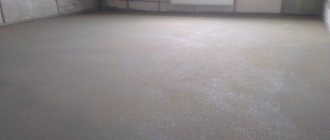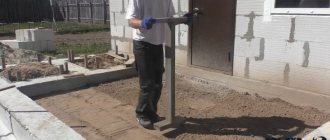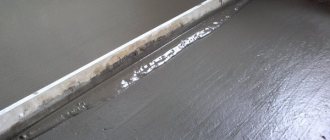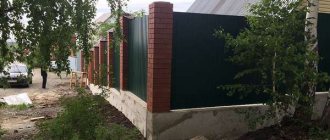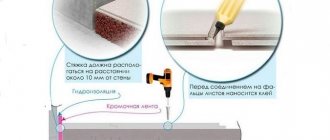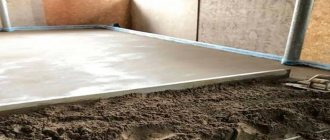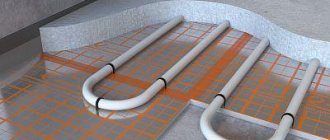What is self-leveling floor
A mixture of cement and sand was usually used to level the floor. But the solution turned out to be heavy; it was not possible to fill small depressions in the base with it and create the most smooth surface possible. Then, to increase plasticity, special components were added to the cement-sand mixture - this is how a self-leveling floor with the necessary characteristics was obtained.
The advantages of self-leveling floors over screed are obvious
Cement- mixtures are used mainly for preparing the base with the subsequent installation of floor coverings made of finishing materials - parquet, tiles, linoleum.
Polymer compositions have been developed specifically for the ideal finishing coating , which form a glossy surface when hardened.
A special feature of self-leveling floors is the minimum thickness of the fill, which is 3 mm.
All types of self-leveling floors are united by a common installation technology. The mixture in liquid form is poured onto the prepared base, leveled and rolled with a roller with needles.
The type of dry mixture or composition is determined depending on the humidity of the room, the required leveling thickness and the intensity of mechanical loads during further operation.
Comparison of characteristics of self-leveling floors
Lightweight reinforced self-leveling floor Lightlayer MN, 20 kg
312
In stock
For high-quality finishing leveling of floors used under conditions of low and moderate loads (residential, administrative, commercial and public premises). Designed using an internal fiber reinforcement system. Recommended for use in underfloor heating systems. Minimum material consumption. Used for interior work in dry rooms. Manual and mechanized application.
BUY
Art. 1210
Moscow and region: Podolsk, st. 8 Marta, no. 2 3386 Availability as of 02/05/2021 2nd Irtyshsky Ave., no. 2A, building 3 349 Availability as of 02/05/2021 Vidnoye, Belokamenny Highway, ow. 10 256 Availability as of 02/05/2021 MKAD, Kaluzhskoe sh., 4, building 5 132 Availability as of 02/05/2021 Istra district, Leshkovo village, no. 118 101 Availability as of 02/05/2021 Istra district , village Zakharovo, ow. 57 95 Availability as of 02/05/2021
Main types of self-leveling floors
Based on the composition of the starting materials, self-leveling floors are divided into two main groups:
- mineral;
- polymer.
The former are a mixture of cement with fillers and belong to the category of self-leveling coatings. They have good binding qualities, so they easily form the base and final surface.
Polymer compositions are used to create a continuous finishing coating.
Self-leveling
Self-leveling floors on a cement-sand base contain additional components that give the mixture plasticity and easy horizontal alignment when installing the coating. Glue, granular filler and tint pigments are also used as additives. The dry mixture is diluted with water to the consistency of liquid sour cream.
After hardening, a smooth and even surface is obtained, in contrast to the use of a conventional cement screed, on which roughness occurs. To install such a coating, professional training is not required; the process is simple and does not take much time. The floors are not afraid of moisture, therefore they are considered universal for indoor spaces and outdoor areas.
Polymer
Depending on what binder is included in the composition, polymer floors are divided into the following categories:
- polyurethane;
- epoxy;
- methyl methacrylate.
The components are mixed using a nozzle attached to a drill for 5 minutes at low speed. The resulting compound is applied as a pour and evenly distributed onto the surface to be treated. The polymer floor is laid on concrete, metal or wooden bases.
Note! The hardening process of thermoplastic resin occurs quickly, so all work from mixing to rolling with a roller with needles is completed within 40 minutes!
Polyurethane
The floor mixture is prepared on the basis of a urethane prepolymer with the addition of a hardener. The mass easily spreads over the surface and after hardening retains elasticity, so during further use it reliably withstands vibrations and temperature changes. The floor is resistant to deformation and shock loads.
Polyurethane coatings are used in industrial and residential premises. Suitable for agricultural enterprises for raising animals and plants, as well as in industrial freezing complexes. For a variety of colors, it is possible to tint the mixture with acrylic paint.
Epoxy
The coating is created from a two-component polymer - epoxy resin and hardener. For the formation of adhesive contact, the degree of heating of the epoxy mixture is of great importance. At elevated temperatures, the viscosity of the resin decreases and a tighter adhesion of dissimilar surfaces is achieved, which ensures long service life.
It is the epoxy floor that creates a glossy surface that resembles the smoothness of glass. Reliable strength allows it to be used in industrial production with intense chemical and moderate physical loads, since high-power pinpoint impacts can destroy the epoxy layer. Due to its abrasion resistance, the coating is even used in parking lots.
Methyl methacrylate
The base is methacrylic acid methyl ester. In the middle of the last century, methyl methacrylate began to be used in the production of plexiglass. Today, improved by polymerization, the composition is used to create particularly durable flooring. The resulting defects or fragments of destruction are easily corrected by local application of the mixture.
Note! Working with methyl methacrylate requires respiratory protection from toxic fumes. It is necessary to use a respirator and provide supply and exhaust ventilation in the room.
Floors made of methyl methacrylate do not deform in the cold; the composition can be applied even at negative temperatures. High strength and abrasion resistance allow the use of MMA in production areas with intense mechanical loads. To form a durable coating, it is recommended to lay the mixture on a concrete base, the thickness of which is at least 70 mm.
What are they?
There are two groups of self-leveling floor mixtures.
Mineral self-leveling floors
Coatings based on cement or gypsum with mineral modifiers and fillers. By varying the ratio of components, you can change the spreadability and hardening time . The purpose of the mixture depends on the fraction and type of fillers: coarse-grained fractions are used for leveling layers (starting floor), fine-grained fractions are used for a thin finishing coating under linoleum, cork, and carpet materials.
The basis of the mixture is Portland cement (gypsum) and fractionated quartz sand. The dry mixture is packaged at the factory and diluted with water before starting work. The main advantage of mineral floors is their high manufacturability ; they are used in various industries. In housing construction, they are used as leveling mixtures for bases under tiles, linoleum, rolled carpets, parquet, etc.
Polymer liquid floors
Such coatings have a synthetic polymer base. See the most common ones below.
Methyl methacrylate
Coatings based on methyl methacrylic resins have high mechanical, chemical and temperature resistance.
Their surface can be smooth or rough (anti-slip), the colors are varied, and they have excellent decorative qualities.
Performance properties vary depending on the use of various additives: if necessary, hardness, ductility, temperature stability, etc. can be adjusted.
They are resistant to ultraviolet radiation and can be used at different temperatures.
The disadvantages include the need for ventilation when pouring due to the strong odor. Polymerization and development of operational strength in just a few hours can also be considered as a disadvantage: pouring such coatings requires highly qualified specialists, whose work is not cheap.
They are used at industrial facilities in various industries: pharmaceuticals, electronics, aircraft manufacturing, trade, etc.
Suitable for use indoors and outdoors. They are more expensive than polyurethane and epoxy coatings.
Epoxy
The working mixture for epoxy floors includes two components: a base of the required color and a hardener . Floors are applied to a previously prepared base. Layer thickness - from 1.5 mm to 5 mm. In residential premises, transparent epoxy floors are installed using photos, 3D compositions or lighting.
Such coatings look interesting; designers love to use them. Quartz-filled epoxy coatings for industrial premises have increased mechanical strength and a non-slip surface.
Disadvantages: low elasticity, insufficient stability against impacts and a moving base.
Epoxy floors can be installed on any substrate and are hard and seamless. The floors are resistant to acids, alkalis, petroleum products, etc. They are used in chemical and pharmaceutical production, in the food industry, in laboratories, car service centers, etc. Convenient and easy to maintain in residential areas.
We recommend: Polymer floors for warehouses.
Cement-acrylic
A combination of cement, polyacrylate copolymer and aggregate. Developed specifically for food industry enterprises with high mechanical loads, large volumes of liquids, treatment with chemicals, steam, disinfection, etc.
The coatings are highly durable - they do not collapse even when cracks appear. Matte surface, anti-slip effect, long service life, chemical resistance, the ability to install on a substrate with unevenness and defects, use indoors and outdoors are the main advantages of cement-acrylic-based floors.
The disadvantages include the complexity of the device.
Polyurethane
Polyurethane is wear-resistant, strong and durable. It is lightweight, holds water well, and is shock and abrasion resistant.
The disadvantages include the need for careful preparation and minimal humidity, as well as increased consumption of materials.
Polyurethane self-leveling floors are often used in individual housing construction, as well as in production, warehouse and other premises.
3D floors
This is the most modern method that is widely used in different countries. The method consists of using a special material with a pattern and a transparent self-leveling coating. Such coatings are exclusive.
We recommend reading: Photos and design of floors made of various materials
Antistatic self-leveling floors
To protect industrial premises and residential areas from the formation of static electricity, a special coating installation technology is used. A conductive circuit made of self-adhesive copper tape is laid on the concrete base, forming a grid with cells of one to two meters. Be sure to ground the ends of the copper strips into a single building system.
Note! Antistatic floors are always used in areas sensitive to electromagnetic fields - computer rooms, air traffic control rooms, laboratories.
To increase the resistivity, a primer layer containing carbon black is applied to the surface prepared in this way. For the finishing coating, polymer compositions with reinforcing fibers made of metal or graphite are used. This results in surface resistance of less than 110 ohms and static leakage in the range of 105 to 108 ohms.
Liquid floor structure
The general structure of self-leveling floors is as follows: concrete base, primer layer, main self-leveling composition, protective varnish. It is worth noting that dismantling the floor after coupling with the rough base is very difficult. Therefore, you need to work without errors, clearly and quickly.
The concrete screed should be free of unevenness, grease stains and dirt. In order for the floor to be perfectly smooth, the surface must be cleaned. Otherwise, the coating will not adhere well, and all irregularities will protrude. You should also pay attention to the cracks in the concrete, which must first be filled with putty, cleaned, then treated with a primer and then proceed to pouring the floor. It is advisable for several craftsmen to fill the floor at the same time due to rapid hardening if the room is large.
Self-leveling flooring has a number of advantages - seamlessness, solidity, variety of types, environmental friendliness of the product and durability. These floors are easy to care for, and if you use your imagination, your home will turn into an exclusive museum.
High-strength floors
To create a smooth surface with a strength of at least 25 MPa, a combination of cement, fractional additives and polymer fillers is used. The mixture is poured with water, mixed and applied to the prepared base within 40 minutes in a layer of 40 to 100 mm. The solution takes a long time to dry, so you can walk on it only 24 hours after pouring.
The composition is intended for basic and final leveling of concrete surfaces, mainly for further laying of finishing coatings. Used in rooms with intensive operating loads - warehouses, basements, garages. Also suitable for underfloor heating systems and the formation of screeds on the separating layer.
Areas of application of self-leveling floors
| Self-leveling | Places with heavy traffic, factories, factories, warehouses, basements, garages. Used as a preparatory layer for subsequent installation of decorative coatings. |
| Polyurethane | Freezers, production workshops, sports facilities, unheated premises, parking lots. Hospitals, clinics, sports facilities, waiting rooms |
| Epoxy | Industrial enterprises, laboratories, utility rooms, hangars, nuclear power plants, medical institutions, shopping and entertainment centers. Country houses, apartments, schools, canteens, restaurants. |
| Methyl methacrylate | Pharmaceutical enterprises, factory floors, industrial freezing units, sports grounds, parking lots, ramps. |
Decorative design of polymer floors
To add decorativeness, epoxy and polyurethane coatings are made with geometric or pictorial patterns. a 3D effect look especially impressive . To do this, a three-dimensional pattern is glued onto the prepared surface, and after 24 hours it is filled with transparent epoxy resin.
The graphic image is applied to paper, fabric or special film. To create a spatial effect with visual perspective, photo printing is used. Fashionable 3D floors are actively used in shopping centers, offices and institutional halls. The hypoallergenic nature of epoxy resin makes it possible to decorate children's playrooms with three-dimensional designs.
flocks - when pouring .
They are available in various colors and sizes. Apply immediately after pouring and rolling, until the coating layer has hardened, by hand or using a flock gun. After 12 hours, the dried surface is coated with colorless varnish or transparent epoxy resin.
Note! Self-leveling floors with silver, gold and multi-colored sparkles look original. The manufacturing technology is the same as creating a coating with flocks. Shiny floors create a festive atmosphere and are used in cafes, restaurants and shopping centers.
Another interesting decoration option is a stone carpet .
Quartz sand with a rich color palette or stone chips are added to polymer resins. To obtain a catchy pattern, several shades are used in one coating, which are applied using stencils.
Depending on the place of use, the stone carpet is made in two versions:
- Open. It has a rough surface that has anti-slip properties. Used in rooms with high humidity or outdoors.
- Closed. It is carried out in two stages - after applying a mixture of mineral filler and polymer component, leave it for 12 hours and apply a transparent layer of epoxy resin. The result is a glossy coating with decorative inclusions inside.
A stone carpet looks original when one of the filling elements is shell rock with a fraction of 50-60 mm. This coating is appropriate to use when decorating the space around swimming pools and artificial reservoirs.
To create luminous floors and paths in the garden, a luminescent component is added.
Price of self-leveling floor and reviews about it
The cost of coverage depends on a number of factors. Firstly, the name of the company plays a role. For a self-leveling floor, “Prospectors,” for example, ask about 400 rubles. This is the price for a 25 kg bag of polyurethane mixture. Self-leveling floor "Yunis" is 100 rubles cheaper. Secondly, the price is determined by the composition. As mentioned, gypsum mixtures are the most cost-effective, while polyurethane and methyl acrylic mixtures are expensive.
To the cost of the mixture you need to add the price for installing the floor. Epoxy, for example, is poured for 200-700 rubles per square. Polyurethane and methyl acrylic options will cost 400-1000 rubles. Concrete coatings cost 100-500 rubles per square. For warehouse floors, price from 990 rub.
Reviews about the self-leveling field are as multifaceted as its varieties. Let's focus on practical aspects that help you create a fashionable coating and, at the same time, save money. Let's start with a review from Oleg Timiryazev from Volgograd: “In my house there are rooms of complex geometry. Cutting out all the corners, columns and protrusions of laminate or parquet turned out to be an expensive murder. The crew puts a price tag on every corner. Polyurethane filling was cheaper for me.”
Oleg left a review on one of the online forums. A certain Gregory spoke there: “I overcame my fear of slippery floors and poured them into the bathroom. I'm glad I listened to the managers. A high-quality composition slides no more than tiles. For 3 years there are no chips, no cracks, no annoying falls.”
The complete list of reviews about self-leveling floors is like volumes of War and Peace. Meanwhile, they are worth reading. Look for different sites, find out opinions about different manufacturers, construction crews, and be interested in the conclusions of your friends who have already filled the floors. The success of repair work largely depends on the quality of the mixture and the skill of the hired crew.
How to calculate the required amount of mixture
To ensure that there is no excess solution left or a shortage of it is discovered during the pouring process, it is necessary to first calculate the exact consumption of the material. To do this, you should know the basic parameters:
- The area of the room that is planned to be filled is S.
- How thick will the layer be – H.
- The mixture density value is P.
By measuring the perimeter of the room with a tape measure, you can easily calculate the area to be filled. The size of the layer is determined depending on the purpose of the self-leveling coating. The density of the mixture is always indicated on the commercial packaging.
To calculate how much mixture is needed, you need to multiply three parameters:
Flow = S x H x P
Then divide the result by the weight of one package and get the exact amount of material needed.
EXAMPLE:
A room of 30 square meters is filled with a layer of 10 mm. The density of the mixture is 2 kg/m2/mm. Packaging 25 kg.
Consumption = 30 x 10 x 2 = 600 kg or 24 bags.
Pouring technologies
Self-leveling floor
Work begins with preparing the base - cleaning it from dust, dirt and elements that can weaken adhesion. If there are cracks, they should first be sealed using a thick cement-based mortar. Then the base is treated with a primer and allowed to dry for an hour. A damper tape is fixed around the perimeter of the surface being poured; this is done to compensate for thermal expansion. Beacons are installed on the base prepared in this way, checking the horizontal position using a level.
The mixture is diluted with water at the rate of 200 ml per 1 kg, it turns out that 5 liters of liquid are needed for a 25 kg bag. Mix to obtain a homogeneous mass using a drill with an attachment or a professional mixer. Take a break for 5 minutes and then stir again. The floor must be poured no later than 40 minutes from the start of mixing.
Note! Excess water will cause the mixture to separate and reduce the strength of the coating.
The floor begins to be poured from the area furthest from the entrance, gradually moving towards the exit of the room. The solution spilled over the surface is leveled with a T-shaped lath and then rolled with a needle roller to remove air bubbles. Until the floor has completely hardened, which will take 24 hours, it is necessary to protect the coating from temperature changes and mechanical stress.
The nuances can be seen in our video:
Polymer floor
The poured polymer compound can be laid on a concrete, wooden or metal base. All gaps, cracks and delaminations must be sealed with special compounds designed to work with a specific material, and then the surface is treated with a primer. A deformation tape is laid around the perimeter and beacons are placed.
Benchmark for self-leveling floor
If the floor is poured in a room with high humidity, then the binder must be waterproofing.
The polymer floor consists of two components, one of which is a hardener. They are mixed for 2-3 minutes in a large container using a spatula attachment attached to a drill. Since a thermal reaction occurs during the mixing process, it is recommended to cool the tank where the mixing is carried out by immersing it partially in cold water.
The floor is poured at a temperature not lower than +10 degrees; at lower values, the floor becomes less plastic. They start from the farthest corner and do not stop, because the finished mixture must be poured in 30-40 minutes. During the pouring process, remove air bubbles using a roller with needles.
During hardening, drafts should not be allowed in the room, because the layer must dry evenly, otherwise cracks will appear.
Depending on the type of polymer and added components, the self-leveling floor can dry to the stage of possible mechanical load from several hours to 3-5 days. Some types of polymer coatings take a week to dry.
Application of Dekotla epoxy self-leveling floor:
